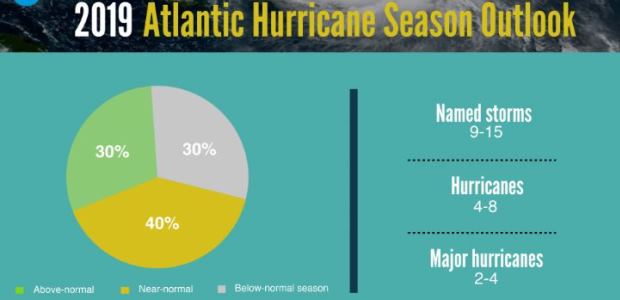
Near-Normal Atlantic Hurricane Season Forecasted
NOAA predicts a likely range of 9 to 15 named storms, including 2 to 4 major hurricanes, for the season beginning June 1. An average hurricane season produces 12 named storms, of which 6 become hurricanes, including 3 major hurricanes.
NOAA's Climate Prediction Center has released its forecast of the 2019 Atlantic hurricane season, which begins June 1, and predicts a "near-normal" season is most likely this year. This outlook forecasts a 40 percent chance of a near-normal season, a 30 percent chance of an above-normal season, and a 30 percent chance of a below-normal season. The hurricane season officially ends Nov. 30.
NOAA predicts a likely range of 9 to 15 named storms (winds of 39 mph or higher), of which 4 to 8 could become hurricanes (winds of 74 mph or higher), including 2 to 4 major hurricanes (category 3, 4, or 5; with winds of 111 mph or higher). NOAA provides these ranges with a 70 percent confidence. An average hurricane season produces 12 named storms, of which 6 become hurricanes, including 3 major hurricanes.
"With the 2019 hurricane season upon us, NOAA is leveraging cutting-edge tools to help secure Americans against the threat posed by hurricanes and tropical cyclones across both the Atlantic and Pacific," said Secretary of Commerce Wilbur Ross. "Throughout hurricane season, dedicated NOAA staff will remain on alert for any danger to American lives and communities."
According to the agency, the ongoing El Nino is expected to persist and suppress the intensity of the 2019 hurricane season. Countering El Nino is the expected combination of warmer-than-average sea surface temperatures in the tropical Atlantic Ocean and Caribbean Sea and an enhanced west African monsoon, both of which favor increased hurricane activity.
"New satellite data and other upgrades to products and services from NOAA enable a more weather-ready nation by providing the public and decision makers with the information needed to take action before, during, and after a hurricane," said Neil Jacobs, Ph.D., NOAA's acting administrator.
The National Weather Service is making a planned upgrade to its Global Forecast System flagship weather model – often called the American model – early in the 2019 hurricane season. NOAA reported that this is the first major upgrade to the dynamical core of the model in almost 40 years and will improve tropical cyclone track and intensity forecasts. "NOAA is driving towards a community-based development program for future weather and climate modeling to deliver the very best forecasts, by leveraging new investments in research and working with the weather enterprise," Jacobs said.
"Preparing ahead of a disaster is the responsibility of all levels of government, the private sector, and the public," said Daniel Kaniewski, Ph.D., FEMA's deputy administrator for resilience. "It only takes one event to devastate a community, so now is the time to prepare. Do you have cash on hand? Do you have adequate insurance, including flood insurance? Does your family have communication and evacuation plans? Stay tuned to your local news and download the FEMA app to get alerts, and make sure you heed any warnings issued by local officials."
NOAA's Climate Prediction Center will update the 2019 Atlantic seasonal outlook in August, just prior to the historical peak of the season.